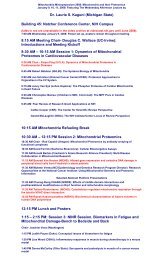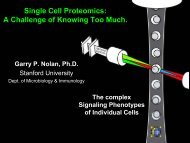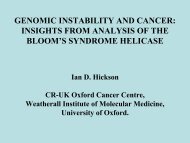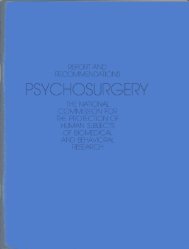RESEARCH ON THE FETUS - National Institutes of Health
RESEARCH ON THE FETUS - National Institutes of Health
RESEARCH ON THE FETUS - National Institutes of Health
Create successful ePaper yourself
Turn your PDF publications into a flip-book with our unique Google optimized e-Paper software.
development are present. Such a prematurely delivered fetus may be considered<br />
at least possibly viable. At these weights and gestational ages, a sign <strong>of</strong> life<br />
such as a beating heart, spontaneous respiratory movement, pulsation <strong>of</strong> the<br />
umbilical cord or spontaneous movement <strong>of</strong> voluntary muscles indicates possible<br />
viability.<br />
Prediction <strong>of</strong> extrauterine viability <strong>of</strong> the fetus while it is still in utero<br />
takes on an additional dimension <strong>of</strong> complexity. The fetus in utero, in the absence<br />
<strong>of</strong> clear signs that death has occurred, is always at least potentially viable as<br />
long as it remains in the uterus. However, it cannot be weighed, size assessments<br />
based on uterine size are inaccurate, and estimates <strong>of</strong> gestational age based on<br />
menstrual history are <strong>of</strong>ten inexact. The best medical technology can provide at<br />
present is an index <strong>of</strong> gestational age based on measurement <strong>of</strong> head size, using<br />
ultrasound. In the best hands, this technique is accurate within ±1 week at<br />
20-26 weeks. Relating gestational age to fetal weight, and taking into account<br />
the range <strong>of</strong> error and normal variation, an estimated gestational age <strong>of</strong> 22 weeks<br />
or less by ultrasound would virtually eliminate the possibility <strong>of</strong> fetal weight<br />
above 600 grams and actual gestational age greater than 24 weeks. Such an estimate<br />
would permit the prediction that if such a fetus were outside the uterus, it<br />
would be nonviable.<br />
Employing present technology, therefore, research on the fetus in utero,<br />
undertaken before an abortion to occur not later than 22 weeks gestational age<br />
as estimated by ultrasound, would not impact on a fetus with a chance for survival<br />
after the abortion. Any reduction <strong>of</strong> the 22 week limit would provide an additional<br />
safeguard.<br />
Whatever the boundaries are for viability, there is always a chance that a<br />
viable infant may be born after a prediction <strong>of</strong> nonviability by gestational age.<br />
When this occurs, the premature infant clearly must be cared for in accord with<br />
accepted medical practice. Further, these criteria for viability are based on<br />
current technology, which is subject to change. Accordingly, the criteria should<br />
be reviewed periodically.<br />
Death <strong>of</strong> the delivered fetus is judged to have occurred when there is a<br />
cessation <strong>of</strong> the minimal basic integrative physiologic functions which, considered<br />
together, may result in self-sustained extrauterine growth and development. The<br />
57











